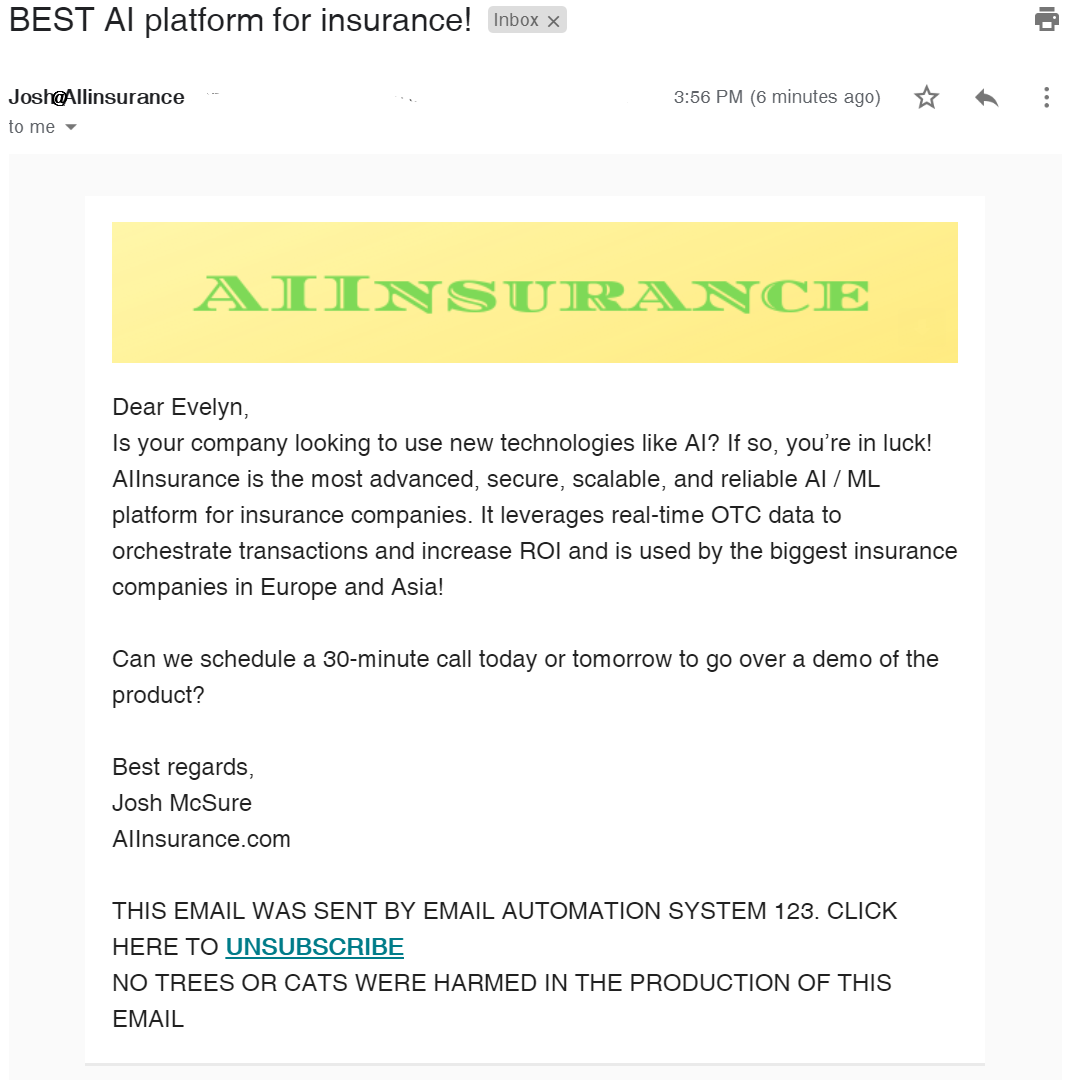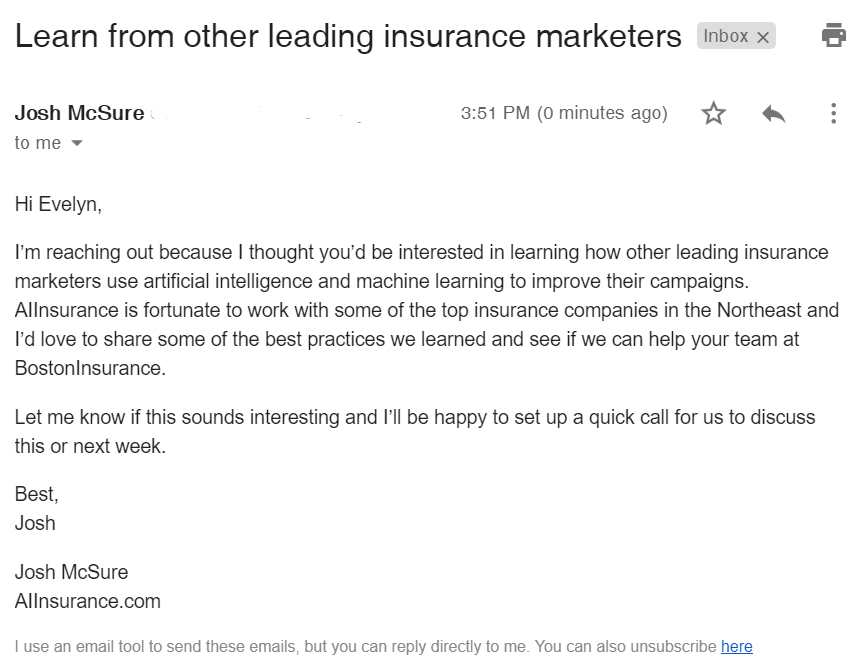Dear <firstname>,
Our Company is the best-in-class, robust, cost-effective AI solution for cutting-edge financial institutions. Do you have questions? We have answers!
Call us ANYTIME!
Ok, so we went slightly overboard, and it’s likely you don’t get emails that read exactly this way. But you probably receive emails that feel like they were written by a buzzword machine and sent to thousands of recipients.
When was the last time you responded to such an email? Probably never.
In this post, we’ll cover how to write human emails that recipients respond to positively. We’ll mostly focus on tone: how to create an engaging one, and what to do — and not to do — to create the ideal email “voice.”
The post discusses outbound prospecting marketing emails that are sent from a person, as opposed to newsletters or other types of mass marketing emails. The goal of outbound prospecting emails is usually to set up an initial sales call with a lead, and it’s a marketing channel we strongly believe in (you can read more about it here).
What is a “human” email, and why is it better than a “non-human” email?
It goes without saying that in B2B marketing, we write and sell to people. Your email reaches a person who opens it, reads it, and decides whether to answer it. This person wants to feel that the sender is also a person, who can understand them and their company’s needs. They want a type of personal interaction it would be impossible for a machine to provide.
A human email reads like it was written and sent by another human being – not by a sales-y, buzzword-y automated email campaign.
If you succeed in sending out human emails, some of your recipients will simply reply. Not everyone, and not all responses will be “let’s set up a meeting,” and that’s ok. To measure the success of your emails, we recommend measuring the number of meetings set up, as well as the number of positive responses you receive. (e.g. positive response = “thanks for the info, but this isn’t relevant right now,” negative response = “please take me off your mailing list”)
Before we dive into the tactics, here are two examples. Read on to understand what makes one “human,” and what are the shortcomings of the other one.


More tactics to make your emails more human
Here are a couple of additional recommended tactics for sending more human and effective emails.
1. Tech & Tools
- The email should look like it was sent from a person: e.g. the sender should be Josh McSure josh@aiinsurance.com (not “info@” or “John @ AIInsurance”). The Reply-To address should also be the same person’s email.
- The email format (visual appearance) should also look like an email coming from a person. No weird fonts, centered text, logos, etc.
- We recommend tools like reply.io that use your actual email account (for example gmail) to send the emails. The downside of such tools is that their daily send capacity is limited to the number of emails the email provider allows – for example, ~400 emails / day for gmail (you can bypass this limitation by creating additional email accounts).
2. Personalized Content. Tailor the email’s content for each person or company. For example, if one of your recipients is a director of marketing analytics in a large insurance company in Boston, you can include information that’s specific and relevant for her:
Hi Evelyn, hope you survived the storm last weekend! I wanted to reach out and share how OurCompany helps other analytics leaders at large insurance providers in Boston get more bang for their marketing buck.
We recommend email content personalization and/or segmentation, but won’t dive deeper in this post.
Our tone of voice
So what’s our recommended tone of voice? First off, there’s no universal tone that’s recommended for every company. It varies according to your target persona, your brand, your company values, and other parameters.
Below is our short writing style guide. You can use it as a basis for your company’s guide. You can also download it here.
Your company’s tone might be different from ours: more or less formal, more or less technical, with a lot of humor or none. And that’s totally fine. Our goal is to emphasize the importance of defining a tone of voice in general, to help ensure your emails feel human and authentic to your brand.
Short writing tone guide
- Imagine you’re writing to a colleague, or a colleague’s boss. A simple tip is using a person’s name when writing the email, instead of “first name.”
Example:
Hi Estaban
Instead of
Hi <first name>
A good question to ask yourself during and after writing is: Would I write this way to Estaban?
- Use professional language but go easy on the industry buzzword and jargon sauce. Using basic industry acronyms (e.g. CTR in marketing) might be fine, but when in doubt, spell them out (CTR = Click-through Rate).
- A bit of humor is ok. Humor is great when it works, and disastrous when it doesn’t. It can be problematic across different cultures or just different people. Our recommendation: if your email is a cake, humor is the cherry on top, not the dough and not the filling. And it’s fine to have a cake without a cherry.
- We like it short. Nobody has time for long emails.
Examples – Do’s and Don’t’s
| Don’t | Do | |
| Use the right level of formality | Dear Darlene
Yo Darlene! | Hi Darlene |
| Minimize / explain buzzwords | Our proprietary, bleeding edge AI / ML engine leverages omnichannel data. | We developed a machine learning engine that uses data from multiple channels. |
| Be humble | OurCompany has the best marketing optimization solution for the biggest banks in the world, guaranteed! | OurCompany is fortunate to work with some of the world’s leading banks on optimizing their marketing campaigns. |
| It’s not about you + mild flattery works | Our product uses the most advanced AI algorithms and has the best TTL performance in the industry. | Other leading marketers use our platform to optimize their campaigns and improve customer communication. |
| Avoid questions | Are you looking for a real-time analytics solution? OurCompany can help!
This is also very common when writing job descriptions. | If you’re looking for a real-time analytics solution, OurCompany may be able to help.
Our team is growing fast and we’re looking for talented and ambitious marketing folks to join us. |
| Keep it short and to the point | If you’re around on the first day of the conference and you can fit in a short meeting in your busy schedule, perhaps we can set up some time for the two of us to meet in person. | Let me know if you’d like to set up a quick meeting the first day of the conference. |
Going further
Once you’ve mastered tone, the next step is to write a comprehensive style guide for your brand that will be used by anyone who writes external communication in your company (essentially everyone). Here’s an excellent example from Buffer, which links to another great example from Mailchimp (side note – we highly recommend following both companies for learning about top-notch tech marketing).
The bottom line
People buy from people and want to communicate with people. The tone of your emails can make a relevant lead reply, so it’s worth investing time in creating a consistent, engaging, authentic, and human writing style for your company.
Download our short style guide template document here.








